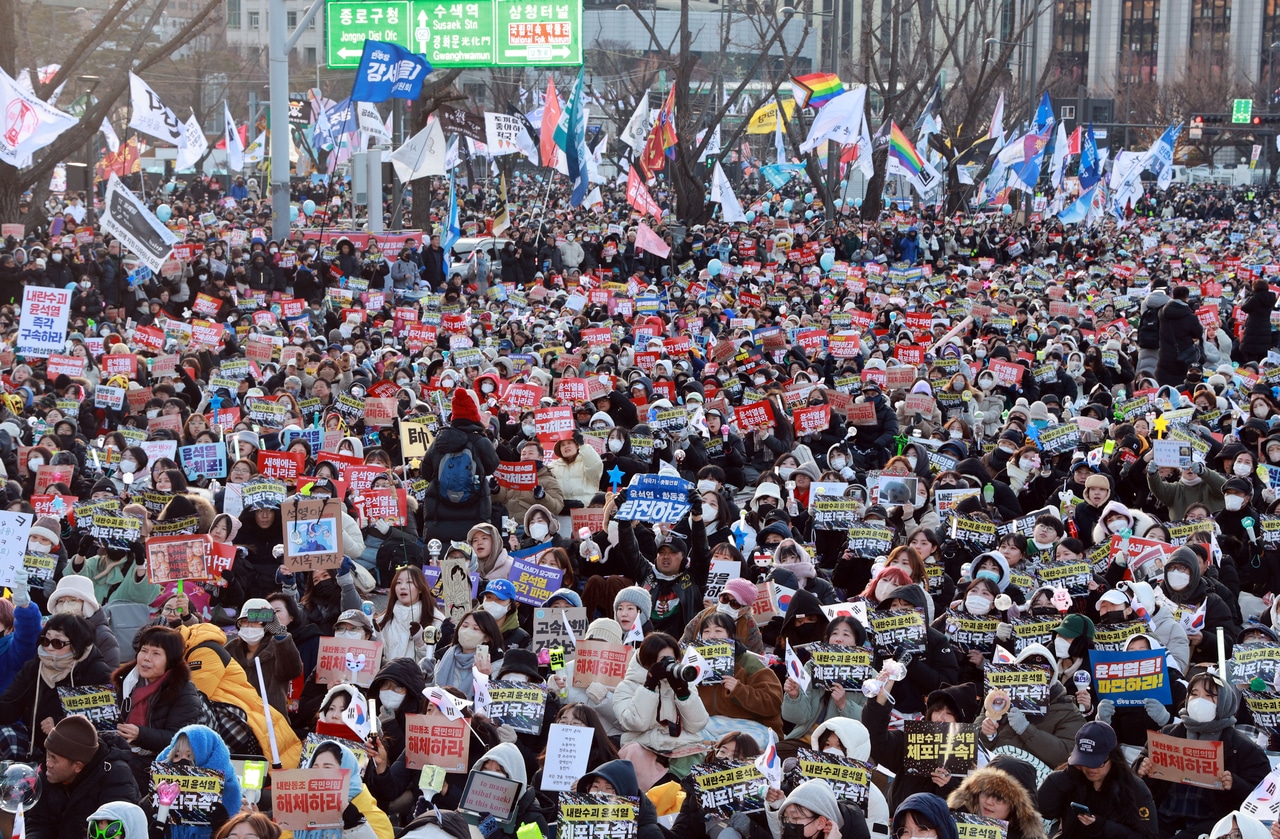
Participants chant slogans during a candlelight rally near Gyeongbokgung Palace in downtown Seoul on Dec. 28, calling for the impeachment of President Yoon Suk Yeol. The rally was organized by the Emergency Action for Yoon Suk Yeol’s Immediate Resignation and Social Reform. (Yonhap via The Korea Herald/Asia News Network)
The entire Korean Peninsula has emerged as one of the top 10 global conflicts to watch this year, driven not only by North Korea’s belligerence but also by political upheaval in South Korea, according to the International Crisis Group’s annual forecast.
Crisis Group cautioned that tensions and uncertainties on the peninsula could intensify, driven by severed inter-Korean ties in the absence of communication channels, deepening military cooperation and exchanges between Russia and North Korea, and the return of President-elect Donald Trump to the White House.
“With much in flux, the Korean Peninsula is set for an edgy 2025,” the Brussels-based Crisis Group, dedicated to conflict prevention and early warning, highlighted its findings Wednesday in its forecast report with Foreign Policy.
READ: North Korea preparing to destroy parts of inter-Korean roads – Seoul
In the 10 Conflicts to Watch forecasts spanning 2015 to 2025, the Korean Peninsula as a whole was never featured on the list. However, the deteriorating dynamics between the US and North Korea were named in the 2020 forecast, while North Korea’s belligerent actions and war threats were listed in the 2018 edition.
The inclusion of the entire Korean Peninsula on the watch list was mainly driven by political turmoil following President Yoon Suk Yeol’s botched declaration of martial law on Dec. 3, which Yoon justified based on “the opposition’s obstructionism,” according to Crisis Group’s forecast.
South Korea concluded the year with “a botched self-coup attempt” by Yoon, which prompted the National Assembly to vote for his impeachment on Dec. 14, the group said, adding, “military officers refused to detain legislators, who quickly vetoed the emergency provisions.”
READ: What we know about South Korea’s martial law
“In Seoul, Yoon’s failed power grab likely heralds further upheaval,” the forecast warned.
Crisis Group warned that the severed ties between the Koreas, including Kim Jong-un’s 2023 declaration of South Korea as a “primary foe” and the cutoff of inter-Korean communication, have heightened the risk of conflict on the peninsula, leaving the two Koreas with “few options to manage incidents at a time of mounting friction.”
Russian President Vladimir Putin and North Korean leader Kim Jong-un exchange documents during a signing ceremony of a new partnership in Pyongyang, North Korea, on June 19, 2024. (File Photo – Kremlin Pool Photo via AP)
Another critical risk arises from the ratified treaty on a comprehensive strategic partnership between Moscow and Pyongyang, which includes a mutual defense commitment and paves the way for North Korean troop deployments in support of Russia’s war against Ukraine.
“Kim’s pact with Moscow -– and the subsequent deployment of an estimated 10,000 elite North Korean troops to Russia’s Kursk region –- links the military balance on the Korean Peninsula to Russian President Vladimir Putin’s war in Europe,” the group said.
What matters more, however, is what Kim has gained — and stands to gain — from these troop deployments, with security implications for the peninsula and beyond.
“The question is what else Pyongyang gets in return,” Crisis Group said. “Closer ties to the Kremlin reinforce Kim’s rule, and Russia is paying for the troops, who will presumably get valuable combat experience.”
Crisis Group predicted that Russia is unlikely to share its nuclear knowhow but finds it plausible that Putin could assist North Korea with ballistic missile technology, potentially enabling it to field missiles with multiple warheads capable of penetrating US and Asian missile defenses.
The group also noted that “Trump’s return adds another layer of uncertainty” to the Korean Peninsula, impacting it on multiple levels.
While Trump is unlikely to withdraw US forces from South Korea or abandon the defense cost-sharing agreement, he may pressure Seoul to increase its financial contributions for hosting US troops.
“That will boost calls, especially among ordinary South Koreans, for Seoul to acquire its own nuclear arsenal. Any ambiguity about Washington’s commitments to Seoul also risks emboldening Kim,” the group said.
The potential for Trump’s return to nuclear diplomacy with Pyongyang, which “if Trump’s team has the bandwidth, would be difficult but worth a shot,” according to the report, introduces an additional factor of uncertainty.
“This time around, negotiations would be tougher. North Korea’s program is more advanced, and Kim’s pact with Russia gives him less incentive to compromise,” the group said.
Crisis Group assessed that “Kim seems unlikely to launch a full-blown war” despite warning from Korea watchers.
“Rather, the main danger lies in miscalculation. Perhaps evidence surfaces of, say, Russian missile technology transfers. Or Kim, animated by his Russia ties, upheaval in Seoul and mixed signals from Trump, pushes the envelope with some form of provocation,” it said. “In both cases, the United States and its allies would face pressure to respond.”

